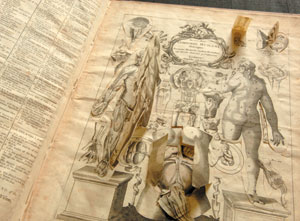|
||
      |
Original Source
Renaissance anatomy

The syllabus for Renaissance Revenge Drama includes not only Shakespeare and his contemporaries, but also 16th- and 17th-century English texts on witchcraft, military strategy, law, meteors, rhetoric, and anatomy. Taught by English professor Carla Mazzio and Special Collections librarian Julia Gardner, the course investigates “the relationships between theater, revenge, and vocabularies of vulnerability, injury, and compensation available to Renaissance writers and dramatists,” according to the course description.
Among the texts Mazzio and Gardner’s students examine is the one at right: A survey of the microcosme; or, The anatomy of the bodies of man and woman, by Johann Remmelin and Michael Spaher. The title refers to the classical idea that the human body constitutes a microcosm of the universe. Published in London in 1702, the book lets its readers “dissect” that human microcosm by hand—pulling up layers of paper flaps to discover the arrangement of muscles, organs, blood vessels, and bones. The Remmelin, says Mazzio, who specializes in Renaissance literature and early modern culture, “puts the readers in an active relationship to learning as they open the body, through the book, with their own hands and eyes.” It also shows, she adds, how “dead, injured, or fragmented bodies became objects not simply of dramatic spectacle but of scientific and philosophical investigation.”